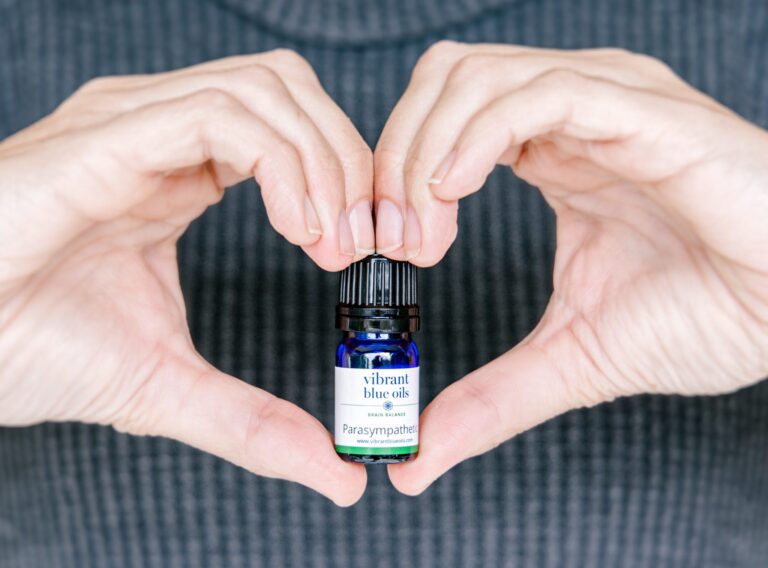Anxiety has become so pervasive that many of you report it has become your “new normal” to live in a state of constant anxiety, fear and overwhelm.
Sadly, living with constant and chronic anxiety keeps your body stuck in a state of stress that can disrupt not only your mental health, but your physical body as well.
Supporting your parasympathetic nervous system can help you reduce your anxiety and support health and healing.
What Causes Anxiety?
Anxiety is triggered by chemical reactions that activate multiple systems in your body and brain, including the activation of your survival mechanism.
Anxiety is a repetitive experience of FEAR.
Some fear is necessary for survival. Fear keeps you on alert to potential or imminent danger. When anxiety occurs, it can feel like the world is unsafe and unpredictable. Your survival mechanisms go on high alert and everything else needs to shut down so you can devote all of your available energy to detecting danger. This danger detection can create a “worst case scenario” cascade where you envision potential worst case scenarios of past, present or future potential danger.
Your view of the world narrows in this state and it becomes all but impossible to see the big picture. Your primal response kicks into gear and everything else has to subjugate itself to the demands of your anxiety’s survival trigger. That means your digestion, immune system, detoxification, and even your awareness and interest in others is diminished. It takes a lot of energy to be anxious.
How Anxiety Affects the Body and Brain
Your sympathetic nervous system is called the “fight-or-flight” system because it’s the first system to turn on when fear occurs. When your sympathetic nervous system is activated, it triggers your heart rate and blood pressure to increase, your breath to quicken, your muscles tighten in anticipation of fighting or fleeing, and your brain scans for danger – all of which present as symptoms of anxiety.
Adrenals– Your sympathetic response triggers your adrenal glands to increase the output of cortisol and epinephrine, giving our organs and muscles the fuel needed to respond to the stress. Over time, excessive cortisol signals your body it’s time to fight or flee, which keeps your perception of stress and anxiety amplified.
Blood Sugar – Anxiety also spikes your blood sugar to provide your body and brain with the fuel your body needs to response to the potential threat or danger. Blood sugar imbalances can contribute to blood sugar dysregulation issues like insulin resistance or hypo-glycemia. When your cells lack fuel and brain fuel, it impairs your ability to think clearly or mobilize yourself out of an anxious situation.
Narrows perception – Your sympathetic response narrows your perception so you can identify and survive threats. Just as the sympathetic nervous system turns off all functions not critical to survival, including your ability to digest food, it also turns off your ability to focus on anything outside of the pressing danger. This hyper focus on danger locks you into a state of constantly scanning for threats, shutting down your ability to thoughtfully contemplate different perspectives that might feel threatening to your safety, which can amplify anxiety.
Excitatory neurotransmitters – Your brain increases production of the excitatory neurotransmitter glutamate, which speeds up brain function and simultaneously reduces your levels of the inhibitory and calming neurotransmitter GABA (gamma-aminobutyric acid), which reduces the experience of anxiety
GABA inhibits brain activity, enabling you to relax. When the sympathetic nervous system is firing, glutamate can be released. In excess, overstimulating brain cells, and presenting as anxiety or a panic attacks.
Research shows that activating your parasympathetic nervous system can help support healthy balance of glutamate — and its counterpart GABA.
When you’re stuck in fight or flight, your glutamate is over-active, lowering your GABA levels, your keeping your brain stuck in the “on” position, triggering anxiety, overstimulation, and overwhelm.
Much as the accelerator and brakes in your car work together to control speed, GABA puts the brakes on brain activity to counter glutamate’s accelerative effects. When glutamate levels are high, you may experience anxiety, restlessness, inability to concentrate, insomnia, fatigue, and increased sensitivity to pain.
As you may recall, your sympathetic nervous system stimulates the motor neurons (for fighting or fleeing) and inhibits the sensory motor system, effectively reducing pain and feeling
How Stimulating Parasympathetic Relieves Anxiety
After a danger or perceived risk passes, you shift out of sympathetic “fight or flight” and return to the “rest, reset and heal” parasympathetic state which allows your body to recover and heal after a demanding physiological and psychological event.
When we are stuck in a cycle of sympathetic dominance – and not activating your parasympathetic nervous system – your body’s alert mechanism for survival remains on high and you can become trapped in a perception that you are not safe, which lays the groundwork for anxiety.
You might think of the parasympathetic response as the brakes on the sympathetic response, which in turn puts the brakes on anxiety. The sympathetic system is employed in states of fear. The parasympathetic system is triggered by a sense of safety.
The parasympathetic system restores a sense of safety and balance which calms the brain and the body by:
Calming neurotransmitters – The parasympathetic nervous system calms the over-activation of glutamate and restores healthy levels of GABA, which calms our panic response, along with balancing other neurotransmitters, including serotonin, which governs general mood, anger, aggression, and fear responses.
Expanding Awareness– The sense of safety allows you to softened and enhance your peripheral view of our surroundings, promoting an expanded awareness that helps you feel calm and safe. Research from the University of Oregon found that “greater parasympathetic activity is a marker of increased selective attention and neurocognitive function.” In the parasympathetic state, your vagus nerve releases the neurotransmitter acetylcholine, to help enhance attention, and learning. In your brain, acetylcholine activates and inhibits communication between different brain regions to properly store information, by speeding up or slowing down nerve signals. In your brain, acetylcholine is mainly excitatory, allowing your neurons to communicate so you can think clearly, learn new information and form new memories.
Stabilizing Blood Sugar – a chronic sympathetic response increases blood sugar and insulin output, creating spikes in the brain’s blood sugar levels which destabilizes brain function. Research with mice in Sweden correlated a significant drop in blood sugar levels as a direct result of the stimulation of the parasympathetic nervous system. The research found that the sympathetic nervous system prepares you to fight or flee by reducing insulin release and increasing blood sugar to boost your energy. The parasympathetic nervous system operates in reverse, lowering blood sugar to healthy levels. (Study).
Restoring heart and respiration rates – healthy heart rate- known as Heart rate variability – helps to calm anxiety. In fact, research correlates healthy heart rate variability, a measure of how quickly you recover from stress, with lower anxiety.
How Parasympathetic Calms Fear and Anxiety
Activating your parasympathetic nervous system helps to inhibit anxiety, according to research which found that – when stimulated, your vagus nerve releases anti-anxiety chemicals that contribute to faster recovery time from illness, injury, stress, and emotional trauma.
Research titled “Fear and anxiety take a double hit from vagal nerve stimulation” documents how activating your parasympathetic nervous system via vagus nerve stimulation helps to quell anxiety and fear.
What’s more, when stimulated, your vagus nerve releases the neurotransmitter Acetylcholine which calms anxiety by relaxing the smooth muscles in your artery walls, dilating the arteries, and slowing your heartbeat. It also may enhance memory consolidation and enhancement which may help with the processing of fear memories, which helps inhibit exaggerated fear expression, like anxiety. (read more about Acetylcholine).
Your vagus nerve helps your autonomic nervous system communicate fear and danger information to your amygdala. In simple terms, the vagus nerve detects the release of the stress hormone epinephrine which acts as a “something important just happened” signal that is communicated to other fear centers in the brain. Activation or inhibition of this signal “can enhance or decrease the rate of fear extinction.”
“By enhancing fear extinction while quelling anxiety, vagal stimulation delivers a double hit against maladaptive fear. This may make vagal stimulation particularly useful in cases where severe anxiety prevents effective exposure therapy.”
You may recall that your vagus nerve controls your relaxation response. In addition to helping you relax by releasing acetylcholine, the vagus nerve’s tendrils extend to many organs, acting like fiber-optic cables that send instructions to release enzymes and proteins like prolactin, vasopressin, and oxytocin, which calm you down.
This is one way the vagus nerve helps counterbalance the effects of the sympathetic nervous system – by signaling for the release of prolactin, vasopressin, and oxytocin, all of which dampen the sympathetic activation and help you calm down, manage and recover more quickly from stress, which helps offset anxiety.
“Centrally released oxytocin has behavioral effects, particularly on social behaviors, and appears to have a calming influence,” according to Science Direct’s “Neurochemistry of Prosocial Decision Making: The Role of Dopamine, Serotonin, and Oxytocin”.
You can naturally stimulate your vagus nerve by topically applying our stimulatory Parasympathetic® behind the earlobe on the mastoid bone where the vagus nerve is closest to the surface of your body.
Stimulating your vagus nerve also triggers the release of the neurotransmitter norepinephrine into an area of the brain called the amygdala, which strengthens memory storage and improves your ability to process and retain information.
Featured Oil:
Ready to get started? Click the link below to order today:
References:
- https://pubmed.ncbi.nlm.nih.gov/6172183/
- https://onlinelibrary.wiley.com/doi/abs/10.1111/psyp.13079
- https://news.ki.se/how-our-nerves-regulate-insulin-secretion
- https://www.ncbi.nlm.nih.gov/pmc/articles/PMC4092363/
- https://www.ncbi.nlm.nih.gov/pmc/articles/PMC4176918/
- https://nba.uth.tmc.edu/neuroscience/m/s1/chapter11.html
- https://www.sciencedirect.com/science/article/pii/B9780128013038000033




